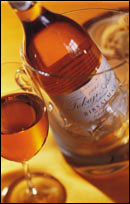 Wines
from Hungary
Wines
from Hungary
 |
| Royal Tokaji Winery |
The classic Tokaji is still by today the greatest asset of the wine growing industry and the investment in quality wine is just moving along.
Bull's Blood of Eger was one of the wines exported but lost it's market place over the years.
Vineyards
|
|
The famous one from Hungary
 The Tokaji region is 200 km Northeast of Budapest in Hungary, and includes 28 villages, covering 5,500 hectares of gently sloping hills formed by ancient volcanoes. It has been described as "Burgundy without signposts", yet it remains hauntingly wild and remote.
The Tokaji region is 200 km Northeast of Budapest in Hungary, and includes 28 villages, covering 5,500 hectares of gently sloping hills formed by ancient volcanoes. It has been described as "Burgundy without signposts", yet it remains hauntingly wild and remote.
In 1700, Tokaji became the first European vineyard to be classified, its uniquely varied terroirs and climates rated "Primae Classis, Secundae Classis, Tertius Classis." The soils are largely clay, with a volcanic substratum. The three principal grape varieties grown in Tokaji are Furmint, Harslevelu, and Muscatel, the latter used as a seasoning, as in Sauternes.
The first Tokaji Aszú wine was created in the 1600's, perhaps by accident, a harvest delayed by threat of enemy invasion. "Aszú is the Magyar term for "dried berries," referring to the botrytis-infected grapes. For maximum botrytis and the almost fiery intensity of great Tokaji, yields must be kept at 10 hectoliters per hectare. In some years no Aszú wines can be made, as botrytis cinerea requires high humidity and a long, warm autumn, with foggy air rising off the nearby Tisza and Bodros rivers.
 The Aszú berries are hand-picked and sorted into "puttonyos", or wooden tubs holding 20 liters of the shrivelled, raisiny, botrytised fruit. "Puttonyos" are used as the measurement of sweetness of the final wine: The more puttonyos, the sweeter, richer, rarer, and more expensive the Tokaji. The berries are crushed and the syrupy Aszú paste is added to each gonci (140-liter barrel) of base wine or "Tokaji Szamorodni", which was made the previous year from unaffected grapes. The mixture is stirred repeatedly for two or more days to extract the natural sugars and aromas of the paste. The small casks are then stored in the cellars, where a second fermentation is caused by the addition of the Aszú paste. This can take several months to several years, due to the cold cellar temperature and the high sugar content of the wine.
The Aszú berries are hand-picked and sorted into "puttonyos", or wooden tubs holding 20 liters of the shrivelled, raisiny, botrytised fruit. "Puttonyos" are used as the measurement of sweetness of the final wine: The more puttonyos, the sweeter, richer, rarer, and more expensive the Tokaji. The berries are crushed and the syrupy Aszú paste is added to each gonci (140-liter barrel) of base wine or "Tokaji Szamorodni", which was made the previous year from unaffected grapes. The mixture is stirred repeatedly for two or more days to extract the natural sugars and aromas of the paste. The small casks are then stored in the cellars, where a second fermentation is caused by the addition of the Aszú paste. This can take several months to several years, due to the cold cellar temperature and the high sugar content of the wine.
Royal Tokaji Wines are matured in dark and narrow tunnels within 14th century underground cellars cut into the volcanic tuff of the foothills. Originally dug out in defense against Turkish invaders, these stone cellars form a veritable maze running for miles underground. Temperature remains constant at 10 degrees C, and the air is purified through a system of drafts called "holes in the soul". Rows of the small casks (gonci) line the moss-and mold-covered vaults in the half-light of flickering candles.
The wines of Tokaji were once among the most prestigious in the world, gracing the tables of royalty and pronounced by Louis XIV, "the wine of kings and the king of wines." During the 20th century, however, they became almost impossible to find due to the European wars. When Hungary fell under Communist rule, all wines were blended by the state-run wineries. Quality declined and individuality disappeared ~ the greatness of the world's original dessert wine seemed lost forever.
The Royal Tokaji Wine Company pioneered the renaissance of Tokaji after the fall of Communism in 1989. A group of foreign investors, including Hugh Johnson and Peter Vinding-Diers, formed the company in cooperation with 63 growers in Mád, the Hungarian village which friends jested was named in anticipation of their joint venture. Agreeing to produce only Aszú wines with four puttonyos or more, and using the classification of 1700 as their guide to the finest terroirs, the association of growers and investors produced their first vintage in 1990. These ground-breaking wines signalled the return of the unique Tokaji style.
With the 1993 vintage, The Royal Tokaji Wine Company produced an array of stunning wines: five different single vineyard wines, two blended Cuvées, and the rare Aszú Essencia. Amber-colored, with honeyed sweetness and elegance, fresh acidity and vibrancy, luxurious and distinctive, these wines "do for the end of a meal what champagne does for the beginning." (Hugh Johnson)
Grape Varieties
|
|
|





